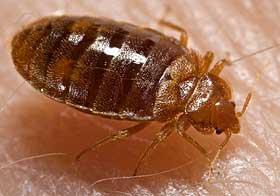Researchers report an increased need for safe bedbug control options. One of the recommended steps for bed bug control is cleaning, although the infestations are not directly related to poor hygiene. What has caused the number of infestations to rise in recent years is not completely understood.
A report published in 2008 compared the number of calls placed to the advisory service at the Danish Pest Infestation Laboratory between 1950 and 2007. The researchers counted the number of requests for information concerning the treatment of bedbug infestations.
The numbers were very low in the 1950s, but gradually increased until the 1980s when they again started to decline. Around 1997, the number of inquiries began to rise once again and have risen every year since. The researchers noted that other European countries were seeing the same trend.
The Danish researchers had a theory that the bugs might have become resistant to the insecticides most often used to treat infestations. As you may know, some types of bacteria have developed a genetic resistance to antibiotic treatment. When a species comes under attack, it either adapts or becomes extinct. Bacteria and insects typically adapt.
To test their theory, the researchers gathered samples from 20 locations. Back at the laboratory, the bug’s sensitivity to four different pesticides was measured. They determined that three of them were no longer effective for bedbug control.
One of the pesticides (chlorpyrifos) tested was still effective, but it has not been used in houses in the US or Europe since 2001. Exposure to the pesticide causes serious health problems in humans. Children are particularly sensitive to the effects of chlorpyrifos.
Exposure causes delays in mental and motor development, as well as long-term problems like ADHD. The manufacturer (Dow) is no longer allowed to market the pesticide as safe following a 2003 settlement in which the company agreed to pay $2 million to the state of New York for failing to report 249 cases of human poisoning.
 Bed bug – Cimex lectulariusPhoto: Piotr Naskrecki
Bed bug – Cimex lectulariusPhoto: Piotr NaskreckiEven if you have a serious need for bed bug control, you don’t want to risk your health or the well-being of your children. If you are like most people, you want safe alternatives.
The safest alternatives take time to work, which is one of the main reasons toxic pesticides were developed in the first place. When faced with an infestation, most people want immediate results. It’s only natural.
What you will need to do is take a deep breath. Effective bed bug control is possible. The insects can be eradicated completely in as little as 10 weeks. What some scientists are recommending is integrated pest management.
Integrated pest management programs involve more than spraying an insecticide. It’s a more complete approach.
By using everything that we know about what will kill the bed bugs quickly or over a period of weeks and what we know about how to keep them out of our beds, we can get rid of them without endangering our own health.
The pesticide least likely to cause problems to human health is diatomaceous earth, a dust consisting of fossilized remains of phytoplankton. Insects need only come into contact with the dust in order for it to be effective. In other words, if an insect walks across the dust, it will eventually die. Death is a result of dehydration.
Most pesticides for bed bug control are neuro-toxins. The same is true of today’s most popular flea treatments. They damage the insect’s nervous system, which means they have the potential to damage the human nervous system, too.
Another safe alternative is a trap that emits carbon dioxide, which is what attracts the bugs to sleeping humans. The traps can be placed under bed posts and other furnishings.
Choosing safer alternatives for bed bug control should prevent the bugs from becoming even stronger in years to come. If we keep using stronger pesticides, we will continue to create more resistant bugs.









New! Comments
Share your tips and feedback. Leave me a comment in the box below.